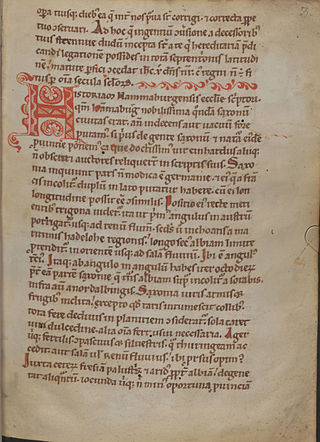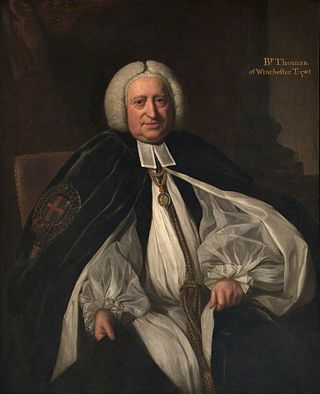
Platycladus is a monotypic genus of evergreen coniferous trees in the cypress family Cupressaceae, containing only one species, Platycladus orientalis, also known as Chinese thuja, Oriental arborvitae, Chinese arborvitae, biota or Oriental thuja. It is native to northeastern parts of East Asia and North Asia, but is also now naturalised as an introduced species in other regions of the Asian continent.

Leo Allatius was a Greek scholar, theologian, and keeper of the Vatican library.

John Caird DD LLD (1820–1898) was a Scottish theologian. He entered the Church of Scotland, of which he became one of the most eloquent preachers. He served as the Principal of the University of Glasgow from 1873 until 1898.
Honorius Augustodunensis, commonly known as Honorius of Autun, was a very popular 12th-century Christian theologian who wrote prolifically on many subjects. He wrote in a non-scholastic manner, with a lively style, and his works were approachable for the lay community in general. He was, therefore, something of a popularizer of clerical learning.

Giuseppe Simone Assemani (Classical Syriac : ܝܵܘܣܸܦ ܒܲܪ ܫܸܡܥܘܿܢ, was a librarian, Lebanese Maronite orientalist, and Catholic bishop. For his efforts, and his encyclopedic knowledge, he earned the nickname "The Great Assemani".

A missal is a liturgical book containing instructions and texts necessary for the celebration of Mass throughout the liturgical year. Versions differ across liturgical tradition, period, and purpose, with some missals intended to enable a priest to celebrate Mass publicly and others for private and lay use. The texts of the most common Eucharistic liturgy in the world, the Catholic Church's Mass of Paul VI of the Roman Rite, are contained in the 1970 edition of the Roman Missal.

Synaxarion or Synexarion is the name given in the Eastern Orthodox, Oriental Orthodox and Eastern Catholic Churches to a compilation of hagiographies corresponding roughly to the martyrology of the Roman Church.

Jean Morin was a French theologian and biblical scholar. His linguistic studies of biblical manuscript material, newly available, were taken to polemical lengths.

The bishop of London is the ordinary of the Church of England's Diocese of London in the Province of Canterbury. By custom the Bishop is also Dean of the Chapel Royal since 1723.

The Bishop of St. Andrews was the ecclesiastical head of the Diocese of St Andrews in the Catholic Church and then, from 14 August 1472, as Archbishop of St Andrews, the Archdiocese of St Andrews.
Ex corde Ecclesiae is an apostolic constitution issued by Pope John Paul II regarding Catholic colleges and universities. Promulgated on 15 August 1990 and intended to become effective in the academic year starting in 1991, its aim was to define and refine the Catholicism of Catholic institutions of higher education.
Eutychius of Alexandria was the Melkite Patriarch of Alexandria. He is known for being one of the first Christian Egyptian writers to use the Arabic language. His writings include the chronicle Nazm al-Jawhar, also known by its Latin title Eutychii Annales.
Herman Scholliner was a German Benedictine theologian and historian.

Gesta Hammaburgensis ecclesiae pontificum is a historical treatise written between 1073 and 1076 by Adam of Bremen, who made additions (scholia) to the text until his death . It is one of the most important sources of the medieval history of Northern Europe, and the oldest textual source reporting the discovery of coastal North America.
Abai was a martyr in Syria. He was killed during the reign of Shapur II. He is a saint in the Syriac Orthodox Church and his feast day is October 1. He is included in Kalendarium Manuale Utriusque Ecclesiae Orientalis et Occidentalis. He had been killed by his father Adorpirozgerd who later became a Christian. He was killed together with other 5000 martyrs including his mother Astina (Hwarta). He was mentioned in the legend of Sābā Pirgushnasp, a child martyr, who had been a son of the governor of Beth ʿArabaye and had been killed under the Shapur II. Approximately the years of his life are 335-385 AD.
Simon Langton was an English medieval clergyman who served as Archdeacon of Canterbury from 1227 until his death in 1248. He had previously been Archbishop-elect of York, but the election was quashed by Pope Innocent III.
John Salmon was a medieval Bishop of Norwich.

John Thomas was an English Anglican bishop. He became Bishop of Peterborough in 1747, and was made preceptor to the future George, Prince of Wales in 1752. In 1757, he became Bishop of Salisbury, and in 1761 Bishop of Winchester.
Thomas Bourchier was an English Observantine Franciscan and martyologist.
Ven. Henry Cotton was an English Anglican divine, ecclesiastical historian and author.











